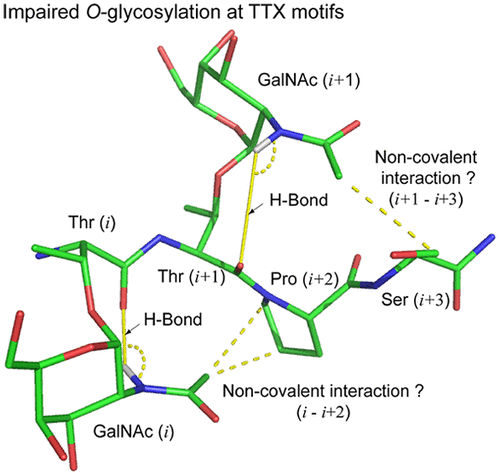当前位置:
X-MOL 学术
›
Biochemistry
›
论文详情
Our official English website, www.x-mol.net, welcomes your
feedback! (Note: you will need to create a separate account there.)
Impaired O-Glycosylation at Consecutive Threonine TTX Motifs in Mucins Generates Conformationally Restricted Cancer Neoepitopes.
Biochemistry ( IF 2.9 ) Pub Date : 2020-03-20 , DOI: 10.1021/acs.biochem.0c00007 Shun Hayakawa 1 , Takahiko Matsushita 2 , Yasuhiro Yokoi 1 , Hajime Wakui 1 , Fayna Garcia-Martin 1 , Hiroshi Hinou 1 , Koji Matsuoka 2 , Kazuhiro Nouso 3 , Toshiya Kamiyama 4 , Akinobu Taketomi 4 , Shin-Ichiro Nishimura 1
Biochemistry ( IF 2.9 ) Pub Date : 2020-03-20 , DOI: 10.1021/acs.biochem.0c00007 Shun Hayakawa 1 , Takahiko Matsushita 2 , Yasuhiro Yokoi 1 , Hajime Wakui 1 , Fayna Garcia-Martin 1 , Hiroshi Hinou 1 , Koji Matsuoka 2 , Kazuhiro Nouso 3 , Toshiya Kamiyama 4 , Akinobu Taketomi 4 , Shin-Ichiro Nishimura 1
Affiliation

|
Autoantibody signatures of circulating mucin fragments stem from cancer tissues, and microenvironments are promising biomarkers for cancer diagnosis and therapy. This study highlights dynamic epitopes generated by aberrantly truncated immature O-glycosylation at consecutive threonine motifs (TTX) found in mucins and intrinsically disordered proteins (IDPs). NMR analysis of synthetic mucin models having glycosylated TTX motifs and colonic MUC2 tandem repeats (TRs) containing TTP and TTL moieties unveils a general principle that O-glycosylation at TTX motifs generates a highly extended and rigid conformation in IDPs. We demonstrate that the specific conformation of glycosylated TTX motifs in MUC2 TRs is rationally rearranged by concerted motions of multiple dihedral angles and noncovalent interactions between the carbohydrate and peptide region. Importantly, this canonical conformation of glycosylated TTX motifs minimizes steric crowding of glycans attached to threonine residues, in which O-glycans possess restricted orientations permitting further sugar extension. An antiadhesive microarray displaying synthetic MUC2 derivatives elicited the presence of natural autoantibodies to MUC2 with impaired O-glycosylation at TTX motifs in sera of healthy volunteers and patients diagnosed with early stage colorectal cancer (CRC). Interestingly, autoantibody levels in sera of the late stage CRC patients were distinctly lower than those of early stage CRC and normal individuals, indicating that the anti-MUC2 humoral response to MUC2 neoepitopes correlates inversely with the CRC stage of patients. Our results uncovered the structural basis of the creation of dynamic epitopes by immature O-glycosylation at TTX motifs in mucins that facilitates the identification of high-potential targets for cancer diagnosis and therapy.
中文翻译:

粘蛋白中连续苏氨酸TTX基序的O-糖基化受损会产生构象受限的癌症新表位。
循环粘蛋白片段的自身抗体特征来自癌症组织,微环境是用于癌症诊断和治疗的有前途的生物标记。这项研究突出了在粘蛋白和内在无序蛋白(IDP)中发现的连续苏氨酸基序(TTX)处异常截短的未成熟O-糖基化产生的动态表位。具有糖基化的TTX基序和包含TTP和TTL部分的结肠MUC2串联重复序列(TR)的合成粘蛋白模型的NMR分析揭示了一个通用原理,即TTX基序处的O-糖基化会在IDP中产生高度延伸的刚性构象。我们证明,在MUC2 TRs中糖基化的TTX图案的特定构象通过多个二面角的协同运动和碳水化合物与肽段区域之间的非共价相互作用而合理地重新排列。O-聚糖具有受限制的取向,允许进一步的糖延伸。显示合成MUC2衍生物的抗粘附性微阵列引发健康志愿者和诊断为早期结直肠癌(CRC)的患者血清中存在天然天然抗MUC2自身抗体,并在TTX基序处O-糖基化受损。有趣的是,晚期CRC患者血清中的自身抗体水平明显低于早期CRC和正常个体的血清,表明对MUC2新表位的抗MUC2体液反应与患者的CRC阶段呈负相关。我们的研究结果揭示了粘蛋白中TTX基序处未成熟的O-糖基化形成动态表位的结构基础,这有助于确定高潜力的癌症诊断和治疗靶标。
更新日期:2020-03-21
中文翻译:

粘蛋白中连续苏氨酸TTX基序的O-糖基化受损会产生构象受限的癌症新表位。
循环粘蛋白片段的自身抗体特征来自癌症组织,微环境是用于癌症诊断和治疗的有前途的生物标记。这项研究突出了在粘蛋白和内在无序蛋白(IDP)中发现的连续苏氨酸基序(TTX)处异常截短的未成熟O-糖基化产生的动态表位。具有糖基化的TTX基序和包含TTP和TTL部分的结肠MUC2串联重复序列(TR)的合成粘蛋白模型的NMR分析揭示了一个通用原理,即TTX基序处的O-糖基化会在IDP中产生高度延伸的刚性构象。我们证明,在MUC2 TRs中糖基化的TTX图案的特定构象通过多个二面角的协同运动和碳水化合物与肽段区域之间的非共价相互作用而合理地重新排列。O-聚糖具有受限制的取向,允许进一步的糖延伸。显示合成MUC2衍生物的抗粘附性微阵列引发健康志愿者和诊断为早期结直肠癌(CRC)的患者血清中存在天然天然抗MUC2自身抗体,并在TTX基序处O-糖基化受损。有趣的是,晚期CRC患者血清中的自身抗体水平明显低于早期CRC和正常个体的血清,表明对MUC2新表位的抗MUC2体液反应与患者的CRC阶段呈负相关。我们的研究结果揭示了粘蛋白中TTX基序处未成熟的O-糖基化形成动态表位的结构基础,这有助于确定高潜力的癌症诊断和治疗靶标。










































 京公网安备 11010802027423号
京公网安备 11010802027423号